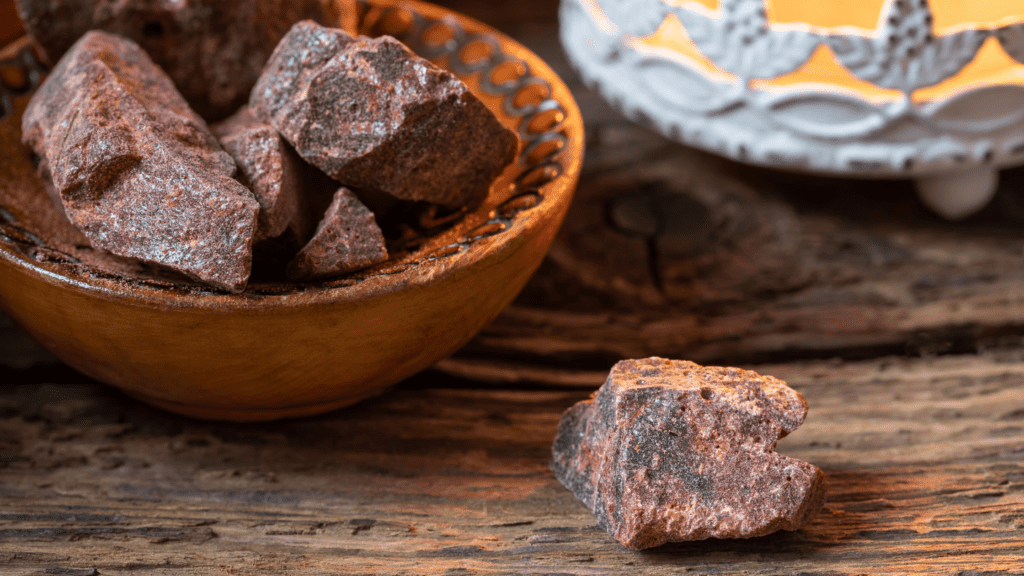
Do you check what goes into the medicine you take? Do you read the label on your cosmetic products? Most of us don’t, and the funny thing about that is that you have probably eaten or used Dragon Blood without even knowing it. Don’t worry. Dragon Blood is a good thing!
Different tree species contain a red resin, also known as Dragons Blood. This nature’s given product has many benefits when used internally and externally. It has anti-inflammatory, antioxidant, and astringent properties used to treat wounds, diarrhea, insect bites, tumors, infections, and more.
Dragon Blood has been used over centuries by many different tribes. Nowadays, scientists have studied the Dragon Blood from different plant species. They have discovered all the many benefits that it contains. These plant species are found in other parts of the world, known by different names. Over time, the use of resin has evolved from being used for ceremonies to putting in cosmetics. In other words, the Dragon Blood might be red, but it is a golden liquid! Want to know more? Keep reading!
Where Does Dragon Blood Come From?
Dragon Blood is a red resin that can come from multiple tree species. This often brings confusion. In images, you will often see a very particular tree (the Dracaena Cinnabari) that grows on the island of Socotra (Yemen) which is more harder to find. In South America, they use the Croton Lechleri, which is the most commercialized. In Asia, dragon blood comes from a Palm (Daemonorops) However, the resin coming from these various species does have similar properties.
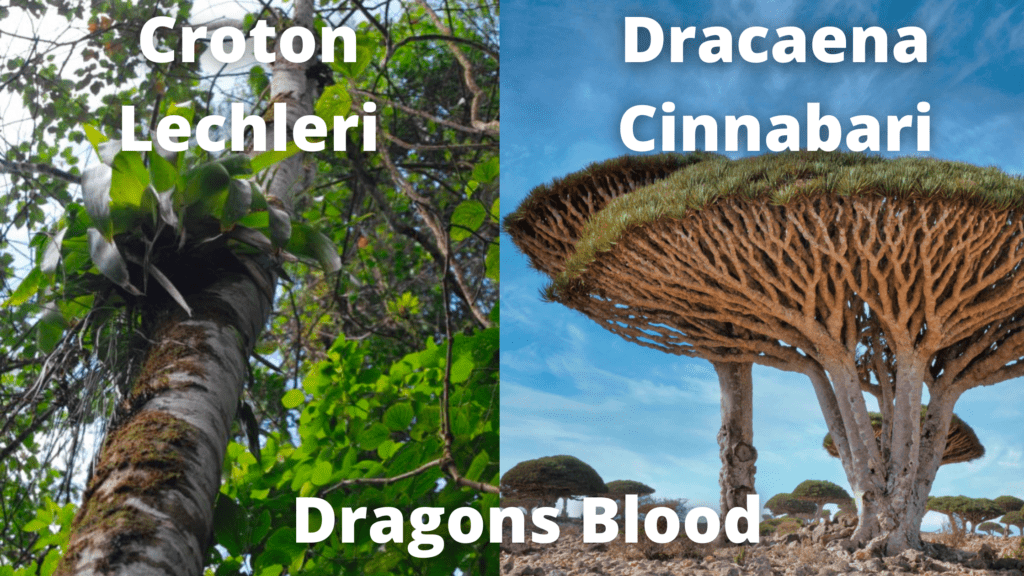
Dragon’s Blood Tree Species and Their Extraction Methods
There are three very popular trees when it comes to harvesting dragon Blood for its health benefits. Below we will dive deeper into the three species, what their benefits are and how they got traditionally used.
1. Croton lechleri

This species grows in South America and gets used by the Indigenous. Different places in South America give this healing tree various names. For example, in Peru, it is called a Sangro de Grado, and in Costa Rica, they call it the Targua.
Extraction
The red resin gets extracted out of the trunk of the tree. When a trunk Is wounded, the red-latex comes out. Most commonly, the extraction is done by placing a tap inside the trunk and catching the sap that comes out. Even though this is the easiest way of extracting the red- resin, it does come with a consequence. When placing a tap inside the tree, damages it, making it weak, and it might eventually even kill it.
2. Dracaena cinnabari
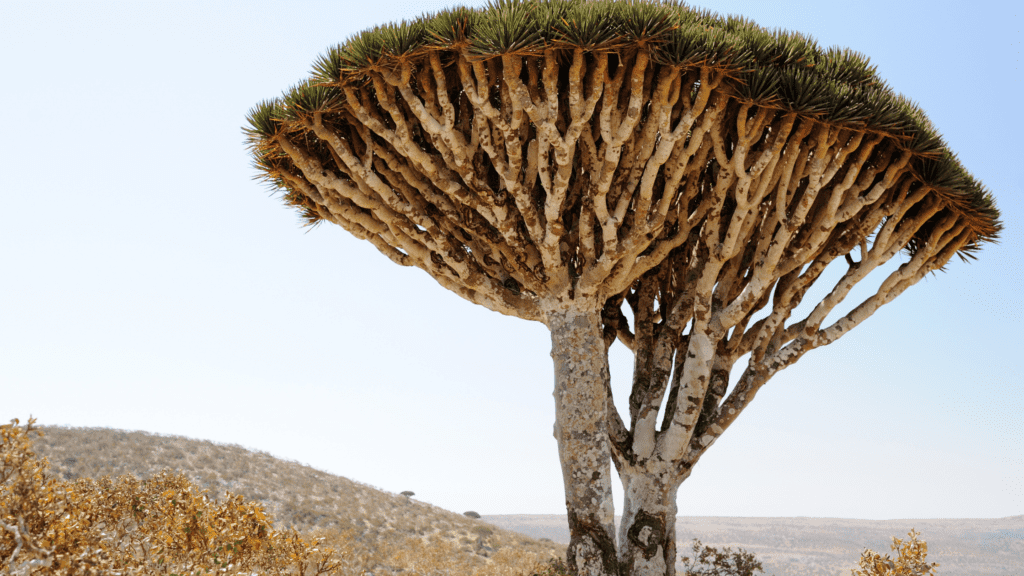
In the Arabian Sea, the Island Socotra is located. The Ancient Romans used the Dragon Blood not only for its medicinal benefits but also for trading.
Extraction
Like the Croton lechleri, the red resin is found inside the tree. The dragon’s blood gets extracted from the stems in the same way as it’s done by the Croton lechleri. Also, the roots of this amazing tree have a gum- resin that gets taken out and used in many different products. And this process can be vital for the tree.
3. Daemonorops
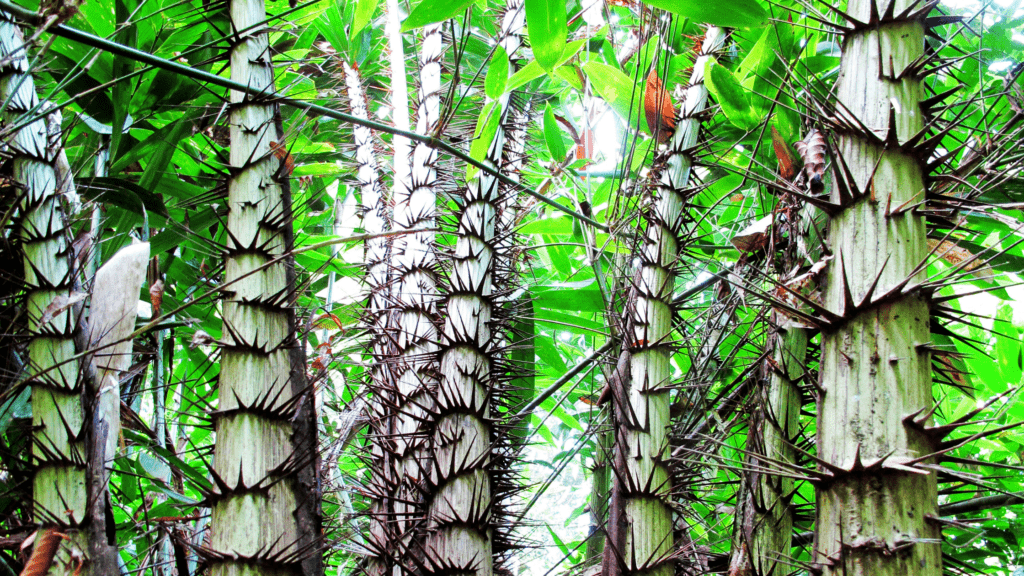
Rattan palm belongs to the Daemonorops family and can be found on the Indonesian islands. If you refer to this tree in Indonesia, the tree would be known as “Djernang.”
Extraction
Unlike the above species, The Dragon’s Blood of the Rattan’s palm covers the unripe fruit that this palm carries. It is simply broken off of the fruit and rolled into balls.
*Interested in what these people used the dragon Blood for? Read the following paragraph!
What are the Benefits of Dragon Blood?
Dragon Blood has three main benefits
- Antioxidant
- Anti-inflammatory
- Astringent
These are the main reasons it has been extracted from the trees for over centuries. It gets used by many different tribes, like the Indigenous, Ancient Romans, and Greeks. Nowadays, it is still used and shipped for production purposes worldwide. So what did Native People, Ancient Romans, and Greeks Use Dragon’s Blood for? And why is it still so popular today? Below you’ll read the answers.
1. Croton lechleri:
Indigenous in South and Central America
Used the Croton lechleri tree sap, the dragon’s blood, as traditional medicine for centuries. It is used to
- Treat physical problems
Like stomach pains and Blood loss - Treat mental problems
It was used in ceremonies to clean out the soul.
Also headaches - The benefits named above are just a few examples. The indigenous used the sap of the tree for many different reasons. They highly believed that it cleaned the body of toxins and stimulated health.
- Present Times
Nowadays, the dragon’s blood of the C. lechleri is commonly used in medicine. Especially to treat
– Diarrhea
– Closing of wounds
– Tumors
– Insect bites
– Infections
– Stomach Ulcers
– Menstrual irregularity
The benefits of this Dragon Blood species have been scientifically researched, which has stimulated the use of the red resin even more https://pubmed.ncbi.nlm.nih.gov/14736360/)
2. Dracaena cinnabari - This species was commonly used by the Ancient Romans and collected on the island of Socotra. The red resin (dragon Blood) was extracted for
– Trading purposes
– Dye
– Painting pigment
– Stomach problems
– Rituals, magic, and Alchemy
Present time
The dragon’s blood of the D. cinnabari is used as a cure-all. Meaning that it is put in many different kinds of medicine to stimulate health and restore the balance in your body. Think of medication to treat
-Lowering Fever
-Diarrhea
–As an Anti- Coagulant (Stop Blood clotting)
–Gastrointestinal problems
–Burns
-As an antiseptic
Like the C. lechleri, the D. cinnibari has been studied well. The dragon’s blood from this tree gets used a lot in different kinds of medication: https://www.hindawi.com/journals/bmri/2021/8561696/
3. Daemonorops
In Indonesia this tree was used as
– Varnish
In the 18th century Varnish was used for Violins
– Toothpaste
– Ceremonies in India
Still varnish, now also incense resin, body oil.
Ceremonies in India
Present time
In the present time, the dragon’s blood of the palm is still used in
– Toothpaste
– Varnish
– Body oil
– Incense Resin
– Mouth wash
Apart from the above mentioned, there are more benefits that Dragon Blood contains. The ones mentioned above have been studied and researched. The three species all include similar benefits and get used for similar purposes. Dragon Blood has been studied for years and is still getting studied today. Some researchers say that the sap of the Dragon Blood tree works as an anti-biotic. However, there is not enough research done to back this up. But we do see a pattern that trees contain substances in their bark and resin to protect them against fungus and diseases, which could explain how they work in humans too.
What are the Different Names for Dragon’s Blood?
As mentioned above, different cultures and parts of the world use Dragon Blood for its many health benefits. Because this plant has different species and is scattered over many parts of the world, it also goes by other names.
Different names for the dragon’s blood
- In Peru dragons blood is called the Sangro de Grado
- In Costa Rica, dragons blood is called Targua
- In Indonesia, they call dragons Blood Djernang
- The Greeks called dragons blood Indian Cinnabar
Indeed more names are out there, but these are the most frequently used names. If you were to name one of these in a country where this tree grows, someone would undoubtedly know what you are talking about.
What Tree Does Dragon’s Blood Come From?
Dragon Blood comes from the Dragon Blood tree, as mentioned before. Dragon Blood tree is the commonly called name. People often don’t know that it is a collective name for many different tropical tree species. Depending on the species, the easily spottable umbrella-shaped tree holds the Dragon Blood resin either in its trunk or around its fruit.
A group of plants makes the Dragon Blood resin. They are also known as
- Croton
- Pterocarpus
- Daemonorops (most well known, used in products, and scientifically researched)
- Dracaena
As mentioned before, even though the Dragon Blood gets extracted from different plant species, they still all have similar properties.
What has Science Said About Dragon’s Blood?
Science has invested lots of time in looking into Dragon’s Blood, why so many people used it over centuries, and why it helps to cure so many different kinds of symptoms and diseases.
The time spend on the research was not for nothing. Researchers have discovered that Dragon’s Blood contains antioxidant abilities. That means that digesting the Dragon Blood will protect people’s cells against free radicals. Free radicals are believed to play a role in many diseases like cancer and heart disease.
With this knowledge, Dragon’s Blood became legal to use in many different types of medicine, as mentioned above.
Apart from this tree providing resources for us humans, scientists have also discovered that the tree itself plays a vital role in the ecosystem. For example, the umbrella-shaped tree provides shelter for many animal species. However, apart from protection, some animals also eat from the tree.
What is Dragon’s Blood Used for?
Dragon’s Blood gets used in many different ways. Externally and internally. The main characteristic of Dragon Blood is that it is astringent, antioxidant, and anti-inflammatory.
- Medicine
It is clear that it gets used in medicine because of its antioxidant and anti-inflammatory characteristics. Most commonly, it gets used to treat
-Digestive problems
-Heart problems
-Cancer
-Menstrual irregularity
The astringent properties of the red resin help to close wounds quickly, as the skin reacts to it. When you apply the resin to a wound it works as a second skin. - Cosmetics
Apart from Dragon Blood having many health benefits, it is also a popular ingredient in cosmetic products like
– Perfume
Dragon Blood has an earthy smell and often gets combined with different scents to make up a nice-smelling perfume.
– Body oil
It works as an anti-inflammatory. Therefore, it helps the skin with rashes and other problems. - Incense
Why is Dragon Blood resin good for incense? Well, that is due again to different reasons
– Intense smell
The powerful earthy smell makes it a suitable aroma for incense.
– Relaxation & Focus
It is believed that incense helps you relax and focus.
– Rituals
Especially the older tribes and the more spiritual people use it in incense as they believe it helps purify the air and heal the soul. - Violin Resin
To protect the violin and give the wood a beautiful color, the Dragon Blood is used as a stained varnish for violins. This is not a new thing, this was already done in the 18th century. - Painting pigment
It is all about the color! The deep red color makes it great for painting. It is often get mixed with other colors. When using this in paint, be aware that not every paint is suitable. - Toothpaste
In the 18th century, Dragon Blood was used in toothpaste. It was mainly a popular ingredient in toothpaste in Chinese herbal medicine. However, finding a toothpaste that contains Dragon’s Blood today won’t be easy. Other cheaper ingredients get used instead of this natural produce. - Spells
Many tribes use Dragon Bloods for spells. The red resin is seen as an offer of Blood. Most spells are about love, sexuality, protection, and cleansing of the soul.
What is Dragon’s Blood Liquid Used for?
If you want to buy Dragon’s Blood, you’ll most often find it as a liquid. The liquid that people buy online in small portions often gets used to
–Sooth the skin and work as a Skincare
-Promote digestion
How do you Make Dragon’s Blood Toothpaste?
Using Dragon Blood in toothpaste is not something new. They started using Dragon Blood as an ingredient in the 18th century. To make Dragon Blood toothpaste, you need to put some of the resin with other ingredients. In the old days, toothpaste consisted of Dragon’s Blood, cinnamon, and burnt alum. It is recommended only to use toothpaste every other day.
The gum-like residue mostly gets extracted from the roots of the plant. The texture of the gum makes it a perfect ingredient to add to toothpaste. The Dragon Blood is also good for your gums and teeth, apart from just the well-working consistency.
Dragon Blood naturally helps against infections. Therefore, brushing your teeth with Dragon Blood can help with sore gums and teeth.
How do I Grow a Dragon’s Blood Tree?
After reading the above benefits of the Dragons Blood tree, the question arises.
Can I grow a Dragon Blood tree?
Can I grow a Dragon Blood tree in a pot?
And How long does it take for a dragon tree to grow?
Might arise. We have some excellent news, Yes you can grow a Dragon Blood Tree. The climate where it grows will determine the time it takes for the tree to fully mature and contain red- resin in its trunk.
Growing a Dragon Blood tree
Dragon Blood trees do best in tropical climates. Therefore, it is essential to plant the tree where it gets enough sunlight and lots of water.
Because this tree needs a lot of water, it gets recommended to use free-draining soil. The roots need to stay well-drained for the tree to grow well. The roots mustn’t be soaked all the time. Otherwise, this will cause them to drown.
Make sure you plant the tree somewhere where it has enough space to grow. The plant can grow from 15- 50 feet (4.5- 15 meters) in height, depending on the species, the climate, and the amount of space it has to grow.
Growing a Dragon’s Blood tree in a pot
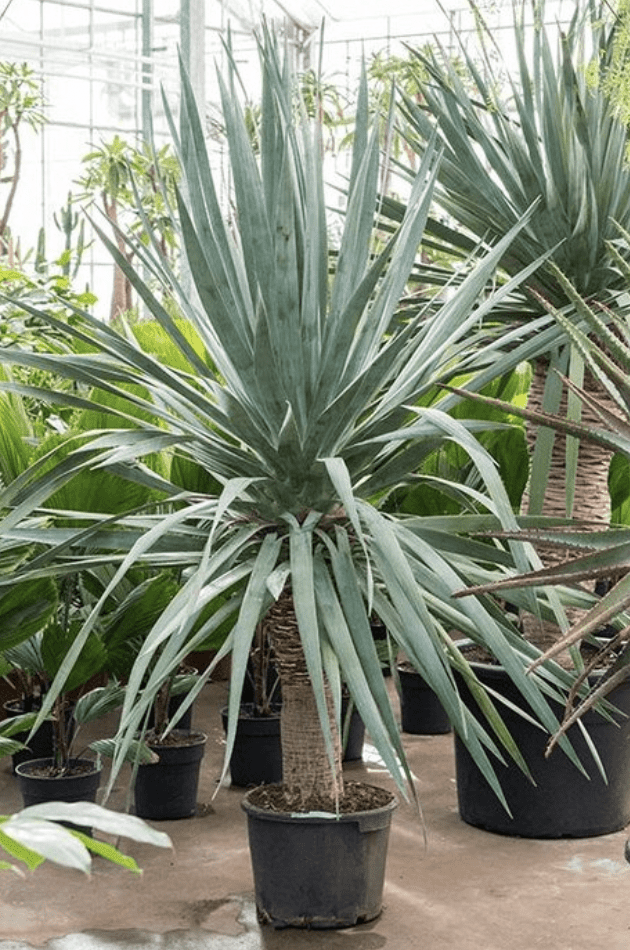
You can grow a Dragon Blood tree in a pot. This is a good idea if you live in cold climates with not a lot of sunlight or if you simply don’t have enough space in your garden. One of the benefits of this tree when growing it in a pot is that it is slow-growing and doesn’t need much attention.
When you decide to grow the tree in a pot, make sure the pot is big enough. It is recommended that the pot is six times the diameter of the tree root ball. Ensure that there are holes in the bottom of the pot so the water can escape. Otherwise, the roots will get too much water, causing mold once the roots come out of the pot, re-pot it into a bigger one. Continue this process
The tree will grow approximately to a height of 3 to 4 feet (about 1-1.3meters)when it is grown inside.
Lastly, to give your plant the most significant chance of growing into a healthy tree, place it somewhere where it gets enough sunlight.
Growing Duration
Because this tree is a slow grower, it will take some time for it to mature. It depends on the species, but it takes about three years for the tree to grow 10 feet (3m) in height.
When you grow the tree in a pot, it takes about ten years for it to grow to its full height of approximately 3 to 4 feet.
Tip
Before you start growing a Dragon Blood tree ask the shop you are getting it from what species it is. This will determine the height and the growing duration of the plant.
Is the Dragon’s Blood Tree Poisonous?
As far as we know, the Dragon Blood tree is not poisonous. The Dragon Blood is used for many health benefits, as described above. However, it is never advised to use a new product when you are pregnant or have some kind of mental or physical issues. If you are not sure if the sap of this tree is good for you, or if you are sensitive to allergies, always ask your doctor first.
What Does Dragon’s Blood Smell and Taste Like?
Like most smells and tastes, the Dragon Blood gets described differently, depending on who you ask.
Smell
When you ask them, most people will say that it has a strong scent. Earthy, amber, vanilla, and smoky are the most commonly used words for people to describe this red resin that comes from the Dragon Blood tree.
Taste
Most people will agree that it is very astringent when it comes to taste. You notice this because your cheeks will get pulled together. When tasting just the resin, your cheeks will probably pull toward each other. Also, some people describe the taste to be pretty sweet. Not a bad combination!
Is the Dragon’s Blood Tree Endangered and how Many are Left in the World?
This popular tree has gotten a lot of attention in the last decade. Unfortunately, the tree has become endangered. The reason for this is primarily due to climate change and development/ deforestation. However, most of these trees are marked as endangered by the IUCN Stanrdasrsd & Petition Subcommittee and the US Wildlife for endangered species; not all species are yet on their list.
- Croton lechleri
As found in South America, the Croton Lechleri, Dragon Blood tree species has not yet been mentioned in the endangered species list. This does not mean that it is out of danger, though. Deforestation and climate changes have a significant effect on this tree. Data says that new trees of this species have not been found growing in nature.
How many are left?
At this moment, there aren’t any numbers stating how many Croton Lechleri trees are left. - Dracaena cinnabari
The famous Dracaena Cinnabri found in Yemen is on the list of endangered species as of 2004. This tree can live for 600 years and grows to be about 30 feet. Unfortunately, the trees in Yemen have had a hard time. Animals like goats and rats have attacked these trees. As a result, fewer and fewer of these Dragon Blood species are found on the island of Socotra today. It is listed as vulnerable by the IUCN Red List of Threatened Species in 2004. Regeneration does not seem to happen either for this tree. Some other reasons why this tree is having a hard time is because it is, of course, used for the resin. Extracting the resin, a.k.a Dragon Blood, from the tree’s bark can damage the tree and even kill it. It is most definitely not sustainable. A few years ago, there was also an incident where many trees got cut down because they wanted to use the trunks to make beehives. This is not allowed anymore as it is now marked as a vulnerable species.
How many are left?
It is hard to say how many Dracaena Cinnabri species are left. Some state that it is about a thousand. Others say only a few hundred are left. It is a fact that the amount is decreasing. Otherwise, it wouldn’t get seen as a vulnerable tree. They are working hard in different nurseries worldwide to give this unique tree species a second life. - Daemonrops
Also, the Daemonrops or Rattan palm mostly gets found on the Island of Indonesia has been marked as endangered as of 2014 by the IUCN Standards & Petitions Subcommittee 2014. The reason that this species has been reduced over the last years is mainly because of tea gardens, eco-tourism, road development, and the removal of forests.
How many trees are left?
Like the above-mentioned Dragon Blood tree species, it is hard to name an exact number of how many trees are left. However, the benefit of this species compared to the other two is that it has a much higher growth rate. Therefore, the chances of survival of this tree are bigger.
Reforestation is something that is getting a lot of attention in the world at the moment. But, unfortunately, climate change, development, and deforestation is doing a lot of harm to mother nature. Hopefully, this beautiful tree, with its many benefits, will get the chance to continue growing and be able to produce Dragon’s Blood.
Some Final Thoughts
Hopefully, after reading the above article, it has clarified what “Dragon Blood is and what its benefits are.” Even though the Dragon Blood resin has been used for decades to help cure mental and physical diseases, it is not as popular as it used to be. This is also due to the fact that many of the species of the Dragon Blood tree are listed as endangered. What makes it harder to obtain the resin. Extracting Dragon Blood can be vital for the tree.
Dragon Blood gets most often used in Chinese medicine in this day and age, so if you would like to know more, this would be a great place to start your research.
The benefits of Dragon Blood are immense. Mother nature makes some great products that humans and many animals can benefit from. It is not just the Dragon Blood tree that gets used for its many benefits.
We loved this photographer’s epic journey to search for the Dragon Blood tree in Socotra, Yemen. It gives a good feel for how this tree grows and what its challenges are.

